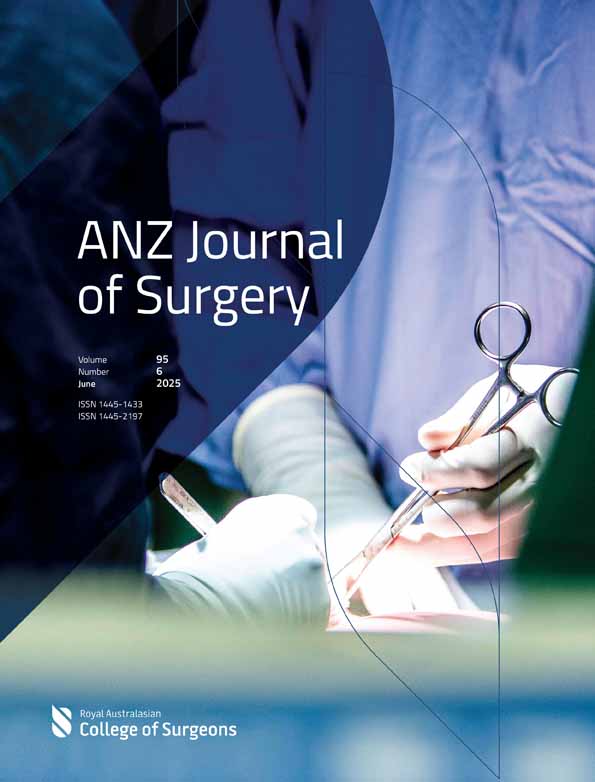HURTHLE CELL NEOPLASMS OF THE THYROID GLAND REVISITED
Corresponding Author
Runjan Chetty
Department of Anatomical Pathology, The Royal Melbourne Hospital, Melbourne, Victoria, Australia
Department of Anatomical Pathology, C/O Post Office, The Royal Melbourne Hospital, Vic. 3050. Australia.Search for more papers by this authorCorresponding Author
Runjan Chetty
Department of Anatomical Pathology, The Royal Melbourne Hospital, Melbourne, Victoria, Australia
Department of Anatomical Pathology, C/O Post Office, The Royal Melbourne Hospital, Vic. 3050. Australia.Search for more papers by this authorAbstract
Hurthle cell tumours (benign and malignant) have been regarded as lesions with uncertain biological behaviour. However recent clinico-pathological studies have shown that they should be categorized as benign or malignant on the basis of capsular and/or vascular invasion, like other differentiated thyroid neoplasms. The fact that the tumours are composed of Hurthle cells is irrelevant. Currently, histological parameters do not seem to predict biological behaviour of Hurthle cell carcinomas.
References
- 1 Askanazy M. (1898) Pathologisch-anatomische Beitrage zur kenntniss des Morbus Basedow, insbesondere uber die dabei auftretende Muskelerkranking. Dtsch. Arch. Klin. Med. 61, 118–86.
- 2
Roediger W. E. W. (1975) The oxyphil of C-cells of the human thyroid gland. A cytochemical and his-to pathologic review.
Cancer
36, 1758–70.
10.1002/1097-0142(197511)36:5<1758::AID-CNCR2820360531>3.0.CO;2-J CAS PubMed Web of Science® Google Scholar
- 3 Welsh D. A. (1898) Concerning the parathyroid glands—A critical anatomical and experimental study. J. Anat. Physiol. 32, 292–307.
- 4 Ewing J. (1919) Neoplastic Diseases—A Textbook on Tumors, 1st edn. WB Saunders, Philadelphia .
- 5
Hurthle K. (1894) Beitrage zur Kenntniss der Secretiononsvorgangs in der Schilddruse.
Arch. Gesamte Physiol.
56, 1–44.
10.1007/BF01662011 Google Scholar
- 6 Bronner M. P. & LiVolsi V. A. (1988) Oxyphilic (Askanazy/Hurthle cell) tumors of the thyroid: Microscopic features predict biologic behaviour. Surg. Pathol. 1, 137–50.
- 7
Hamperl H. (1962) Benign and malignant on-cocytoma.
Cancer
15, 1019–27.
10.1002/1097-0142(196209/10)15:5<1019::AID-CNCR2820150519>3.0.CO;2-5 PubMed Web of Science® Google Scholar
- 8 Lennox B. (1948) The large-cell small-acinar thyroid tumour of Langhans and the incidence of related cell groups in the human thyroid. J. Pathol. Bacteriol. 60, 295–305.
- 9
Heimann P.,
Ljunggren J. G.,
Lowhagen T. et al. (1973) Oxyphilic adenoma of the human thyroid.
Cancer
31, 246–54.
10.1002/1097-0142(197301)31:1<246::AID-CNCR2820310133>3.0.CO;2-B CAS PubMed Web of Science® Google Scholar
- 10 Tremblay G. (1969) The oncocytes. In: Methods and Achievements in Experimental Pathology (Ed. E. Bajusz and G. Tasmin), vol. 4. Karger, New York .
- 11
Gordon P. R.,
Huvos A. G. &
Strong E. W. (1973) Medullary carcinoma of the thyroid gland. A clinicopathological study of 40 cases.
Cancer
31, 915–24.
10.1002/1097-0142(197304)31:4<915::AID-CNCR2820310424>3.0.CO;2-A CAS PubMed Web of Science® Google Scholar
- 12 Chetty R. (1990) Hurthle cell medullary carcinoma of the thyroid gland. S. Afr. J. Surg. 28, 95–7.
- 13
Seizer G.,
Kahn L. B. &
Albertyn L. (1977) Primary malignant tumors of the thyroid gland: A clinicopathologic study of 254 cases.
Cancer
40, 1501–10.
10.1002/1097-0142(197710)40:4<1501::AID-CNCR2820400422>3.0.CO;2-X PubMed Web of Science® Google Scholar
- 14 Chetty R. (1990) Hurthle cell neoplasms of the thyroid gland: an immunohistochemical study. Histopathology 17, 368–70.
- 15 Arganini M., Behar R., Wu T-C. et al. (1986) Hurthle cell tumors: A twenty-five-year experience. Surgery 100, 1108–15.
- 16 Thompson N. W., Dunn E. L., Batsakis J. G. et al. (1974) Hurthle cell lesions of the thyroid gland. Surg. Gynaecol. Obstet. 139, 555–60.
- 17 Bondeson L., Bondeson A-G., Ljungberg O. et al. (1981) Oxyphil tumors of the thyroid. Follow-up of 42 surgical cases. Ann. Surg. 194, 677–80.
- 18 Caplan R. H., Abellera M. & Kisken W. A. (1984) Hurthle cell tumors of the thyroid gland. A clinicopathologic review and long-term follow up. JAMA 251, 3114–17.
- 19 Watson R. G., Brennan M. D., Goellner J. R. et al. (1984) Invasive Hurthle cell carcinoma of the thyroid: natural history and management. Mayo Clin. Proc. 59, 851–5.
- 20 Heppe H., Arnub A., Calandra D. B. et al. (1985) Hurthle cell tumors of the thyroid gland. Surgery 98, 1162–5.
- 21
Carcangiu M. L.,
Bianchi S.,
Savino D.,
Voynick I. M. &
Rosai J. (1991) Follicular Hurthle cell tumors of the thyroid gland.
Cancer
68, 1944–53.
10.1002/1097-0142(19911101)68:9<1944::AID-CNCR2820680917>3.0.CO;2-I CAS PubMed Web of Science® Google Scholar
- 22 Grant C. S., Barr D., Goellner J. R. & Hay I. D. (1988) Benign Hurthle cell tumors of the thyroid: A diagnosis to be trusted. World J. Surg. 12, 488–95.
- 23
Flint A.,
Davenport R. D.,
Lloyd R. V. et al. (1988) Cytophotometric measurements of Hurthle cell tumors of the thyroid gland. Correlation with pathologic features and clinical behaviour.
Cancer
61, 110–13.
10.1002/1097-0142(19880101)61:1<110::AID-CNCR2820610119>3.0.CO;2-4 CAS PubMed Web of Science® Google Scholar
- 24 Bronner M. P., Clevenger C. V., Edmonds P. R. et al. (1988) Flow cytometric analysis of DNA content in Hurthle cell adenomas and carcinomas of the thyroid. Am. J. Clin. Pathol. 89, 764–9.
- 25 Ryan J. J., Hay I. D., Grant C. S. et al. (1988) Flow cytometric DNA measurements of benign and malignant Hurthle cell tumors of the thyroid. World J. Surg. 12, 482–7.
- 26 Schark C., Fulton N., Jacoby R. F. et al. (1990) N-ras 61 oncogene mutations in Hurthle cell tumors. Surgery 180, 994–1000.




